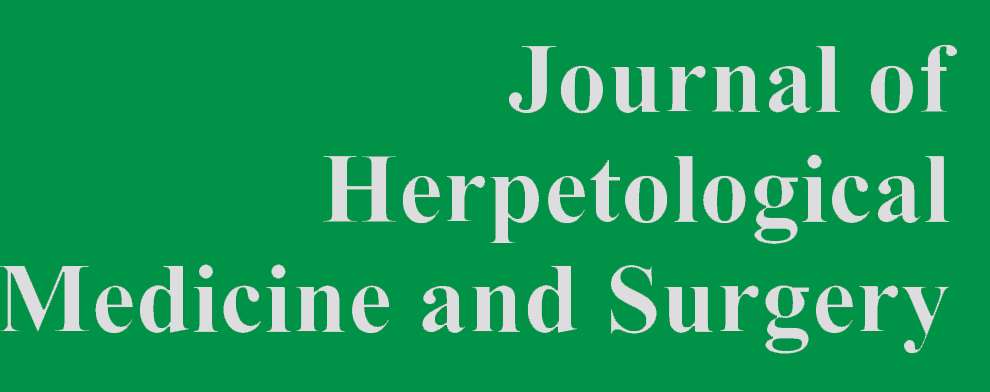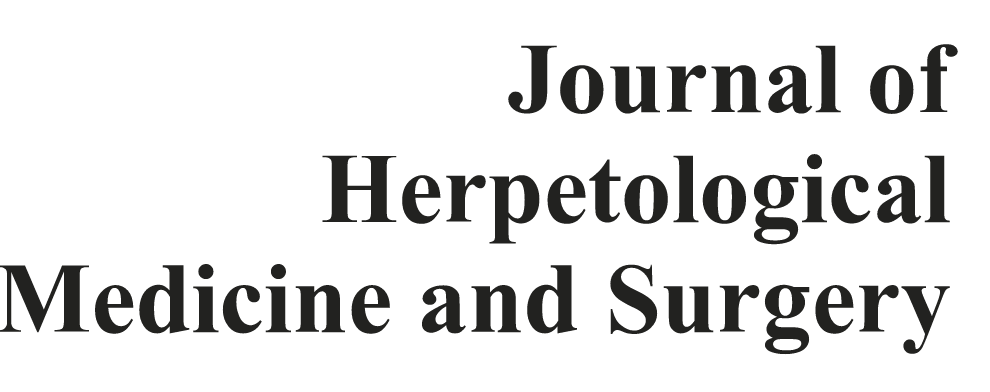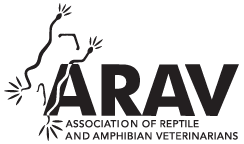Guidelines for Authors
The Journal of Herpetological Medicine and Surgery (JHMS) is designed to be a source of information for veterinarians and others involved in the health of reptiles and amphibians. JHMS is interested in all aspects of care for these species, including natural history and maintenance in captivity as well as particular medical and surgical problems.
Manuscripts are expected to be original works that have not been previously published (with the exception of abstracts of 250 words or less). All authors are welcome to submit manuscripts for consideration. Student authors (including undergraduate, veterinary, graduate, residents, interns, etc.) enrolled in a full-time education program will be granted a complimentary 1-year online student membership to the Association of Reptilian and Amphibian Veterinarians once they have completed the submission process. Please contact the Managing Editor, Dana Varble, at dvarble@navc.com for further information.
English language editing is available through Charlesworth Author Services at a discounted price for JHMS authors through cwauthors.com/BioOne.
Authors may submit manuscripts for publication in the following sections:
In My Experience: Brief clinical experiences regarding adverse or unusual drug reactions, empirical drug dosages, therapeutic modalities, diagnostic aids, disease trends, species idiosyncrasies, and herpetological medicine care and husbandry in general.
Brief Communication: Brief Communications provide substantive information on research observations or clinical cases (case reports). Reports of single cases should include novel information or insights, for example, description of a novel diagnostic or therapeutic approach, a disease process not previously described in a given species, a previously undescribed etiology, or a disease not well described in the literature.
Case Series: Reports of clinical cases with detailed introduction, signalment, history, captive care, laboratory and pathologic data, diagnosis, therapy and results. Cases should be unusual or novel; however, they do not have to have a successful outcome. They should be informative to veterinary practitioners. The discussion should emphasize the important clinical, pathologic, and therapeutic features, as well as identify what is new and not previously appreciated. A complete and up-to-date review of literature should be included on the topic in the discussion.
Original/Review/Roundtable Articles: In-depth articles of discussions focusing on a specific disease or topic, review of literature relating to a specific topic, and clinical data and research concerning specific diseases or species. An approved Institutional Animal Care and Use Committee (IACUC) protocol number must be provided for manuscripts involving animal research. If a protocol number is not available, an explanation should be forwarded with the manuscript. JHMS reserves the right to decline manuscripts for any animal safety and welfare concerns.
Manuscript Submission: Manuscripts should be submitted electronically at jhms.allentrack2.net. Before you use the JHMS website, you must first register on the site. There is online help to assist you or you can contact the Editor-in-Chief, Mark A. Mitchell, DVM, MS, PhD at mmitchell@ lsu.edu. Manuscript files should be submitted in Microsoft Word format. Tables should be in XLS or doc formats. Figures and images should be 300 dpi, TIFF, EPS, PDF, or JPG formats.
-
An abstract is required for all manuscripts, except In My Experience. The abstract should be no longer than 250 words and summarize your key points.
-
A list of five key words should precede all articles. Key words should include genus and species.
-
Species mentioned should be listed by common name and then italicized taxonomic name (e.g., inland bearded dragon, Pogona vitticeps). Where applicable, sex, age, whether wild caught or captive born, and length of time in which its history can be documented should be included.
-
All measurements should be given in the metric system. Biochemical values should be listed in International System (SI) units with conventional units in parentheses, or on the next line (if in a table). Temperatures should be in Celsius, with Fahrenheit in parentheses.
-
Abbreviations may be used in the text if the full meaning was previously stated but should not be used to begin a sentence. Standard pharmaceutical abbreviations need not be explained. Numbers less than 10 should be spelled out.
-
Drugs and all other products should be listed by generic or chemical name followed by, in parentheses, trade name, concentration, manufacturer, city, state two-letter abbreviation, and country. Dosages of all drugs should be given in mg/kg or ml/kg (if mg unit is inappropriate), not how many milligrams or milliliters were given to an individual animal. Route of administration (abbreviated), frequency of dosage, and duration of treatment should be indicated. For example, 2.5 mg/kg amikacin (Amiglyde V, 250 mg/ml, Fort Dodge Laboratories, Fort Dodge, IA, USA) SC q 72 hr for six treatments.
-
When preparing the manuscript and literature cited, peer-reviewed journal papers or published book chapters are considered most impactful, whereas non–peer-reviewed, unpublished, or poorly available proceedings papers are considered less valuable and should be avoided.
-
Literature should be cited by author and year, in parentheses, and then listed in alphabetical order at the end of the text. For references with three or more authors, citations in text need to include only the first author followed by et al.; all authors should be listed under Literature Cited. Journal titles should be abbreviated in a consistent manner. Use the following style: (Wellehan, 2019) then (Schumacher et al., 1994) then (Sladky and Mans, 2019).
Chapter or Article in a Book
-
Sladky KK, Mans C. 2019. Analgesia. In Divers SJ, Stahl SJ (eds): Mader's Reptile and Amphibian Medicine and Surgery. Elsevier, St. Louis, MO, USA: 465–474.
Article in Journal
- 2.
Schumacher J, Jacobson ER, Homer BL, Gaskin JM. 1994. Inclusion body disease in boid snakes. J Zoo Wild Med, 25(4):511–524.
Proceedings
- 3.
Stöhr AC, Nevarez JG. 2019. Blood transfusions in reptiles: Why don't we do more? Proc ExoticsCon, 915.
In Press
- 4.
Kolesnik E, Hyndman TH, Müller E, Pees M, Marschang RE. 2019. Comparison of three different protocols for the detection of ferlaviruses. BMC Vet Res, in press.
Thesis/Dissertation
- 5.
Floyd RB. 1983. Thermal Physiology of Bufo marinus Embryos and Larvae: The Ecological Significance of Laboratory Observations. PhD. Diss., School of Australian Environmental Studies, Griffith University, Queensland, Australia.
URL
- 6.
OIE World Organization for Animal Health. Batrachochytrium salamandrivorans. Available from: http://www.oie.int/fileadmin/Home/eng/Internationa_Standard_Setting/docs/pdf/Aquatic_Commission/A_BSAL_Disease_card.pdf. Accessed 2019 Aug 06.
Personal Communications
If personal communications are referenced in a manuscript, the first initial(s), last name, highest academic degree of the source of the information, “personal communication”, and the year in which the information was obtained should be listed in the text (D. Varble, DVM, personal communication, 2019). Personal communications should not be listed under Literature Cited.
- 9.
There is no charge for submitting color images, and color images are preferred. Short figure legends should be provided for each figure that includes the species, stain, and original magnification or bar scale. Each figure, table, or photograph should be submitted as a separate file with a corresponding file name.
- 10.
For digital art, the screen display of an image is much different from the printed version. The resolution of an image on the computer screen, which is usually 70–90 dpi, is too low for adequate quality in a final printed form. For publication purposes, images must be at least 1,200 dpi or 50 pixels/mm for line art and 300 dpi or 12 pixels/mm for grayscale or color illustrations or photographs. Combination art (illustrations/photographs with text) should be saved at a resolution of 600 dpi or 25 pixels/mm. Digital art should be cropped as close as possible to the image boarder (1 or 2 points).
- 11.
All manuscripts are submitted with the understanding that all authors have seen the article. JHMS reserves the right to reject any manuscript. Submitted manuscripts are subject to anonymous peer review. Authors are expected to respond to reviewers' comments and make revisions within 30 days. Revised manuscripts may be sent out for review again. Manuscripts that pass peer review are accepted for publication once the author has addressed all questions and concerns raised by reviewers and editorial staff.
- 12.
Acknowledgments should be limited to persons who have contributed materially to the content.
- 13.
If funding or support for an article was provided, it should be stated. Any potential conflict of interest or financial disclosures should also be included.



